by Jennifer Wood, via complex.com

From Truman Capote to Anne Rice, Louis Armstrong to Lil Wayne—not to mention all those Neville and Marsalis family members—The Big Easy has never been short on creative talent. Whether it’s literature, music, or any and every other art form in between, this vibrant Southern city has served as an inspiration for those who have called it home, or who have merely passed through its charming, French- and Spanish-inspired streets, for nearly 300 years.
While it may be best known for its vibrant music scene, New Orleans’ history of visual artists—painters, photographers, sculptors, video artists, and beyond—rivals that of any other city packed with sleek galleries and slick collectors. Though the local art community has lost some of its greatest inspirations in recent months—including George Dureau and George Rodrigue—the fierce passion of the city’s established and emerging artists continues to evolve and make NOLA a hotbed of creative activity. Here are 20 New Orleans Artists You Should Know.
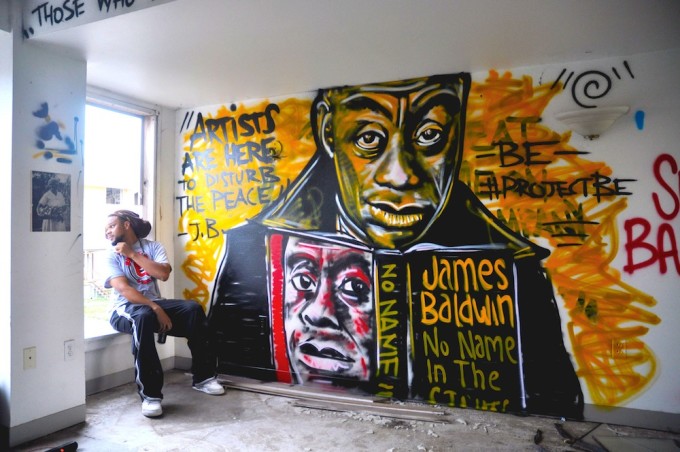
Image via Brandan Odums
It wouldn’t be incorrect to call Brandan “bmike” Odums an “artist,” yet his work seems to beg for a more all-encompassing descriptor. As the founder and director of 2-Cent Entertainment, a youth organization that bridges the gap between pop culture and social awareness, Odums uses art as a tool for activism. Working in a variety of media, Odums has used both the lens of his video camera and the nozzle of a spray paint can to highlight the challenges of modern-day New Orleans. In 2013 he gained nationwide attention for “Project Be (#ProjectBe),” a series of graffiti murals depicting iconic African American civil rights crusaders that he painted on the sly on the walls of a soon-to-be-demolished-and-rebuilt public housing complex in the 9th Ward. Odums is as dedicated to honing his own art as he is to empowering the city’s youth to channel their creativity into positive projects, which bodes well for the next generation of NOLA artists.
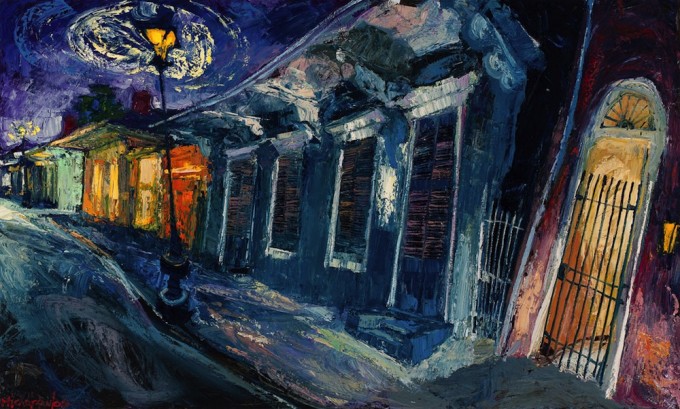
Image via James Michalopoulos
James Michalopoulos may not have been born in New Orleans, but the city—which he has called home for more than 30 years—is clearly in his blood. And perhaps it’s partly because of that outsider/insider perspective that he’s able to capture its well-known streets, sidewalks, and buildings, while at the same time hinting that it’s ultimately unknowable. His vibrant oil paintings and large-scale steel structures have come to stand as truly iconic representations of the city, and his works are part of the permanent collections of museums (including the New Orleans Museum of Art and Ogden Museum of Southern Art) and private collectors (from Aaron Neville to Bruce Willis) all over the world. Perhaps one of the greatest testaments to Michalopoulos’ status as a NOLA icon is that he has been commissioned on a half-dozen occasions to create original paintings for the city’s official Jazz Fest posters. It’s also worth noting that Michalopoulos’ has planted his NOLA roots beyond the art world; he’s also the owner of Celebration Distillation, the near-20-year-old distillery that makes Old New Orleans Rum.
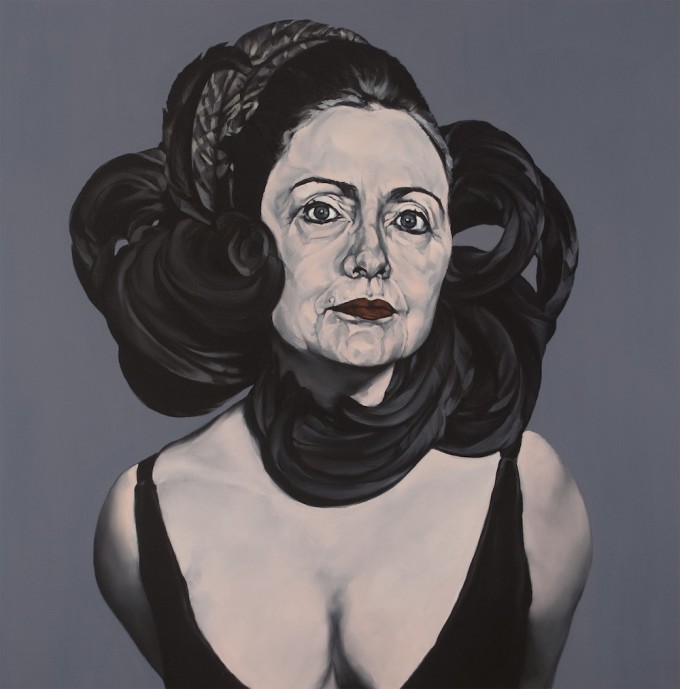
Image via Sarah Sole
If the name Sarah Sole doesn’t ring a bell, what about Sarah Ferguson? No, not the Duchess of York. We’re talking about the Sarah Ferguson who created a bit of a viral storm back in 2012 when her satirical paintings of Hillary Clinton—in a variety of poses (sometimes compromising) and states of undress (sometimes with no dress at all)—were discovered by BuzzFeed. Well, she and Sarah Sole are one in the same. “Funny, I spent a year and a half trying not to paint Hillary,” Sole (as Ferguson) told The Huffington Post in 2012. “I just painted other things, other compositions, avoiding portraits in general, but Hillary in particular. Then I decided to create a pseudonym, a new name that I would create and publish work under online. It was like somehow Sarah Ferguson had too much baggage. I wanted to unload it.” Hence the revamped surname, but the talent, coupled with a sense of humor, remain intact. And Hillary is still very much in the picture for this politically-minded SVA grad, who will be showcased alongside more than 30 other NOLA artists as part of the Contemporary Arts Center New Orleans’ “Mark of the Feminine” exhibition, which runs through October.

Image via Eddie Lanieri
Photographer Edna “Eddie” Lanieri is yet another NOLA artist whose work will be showcased as part of CAC’s “Mark of the Feminine” exhibition, and it’s easy to see why. Lanieri’s arresting portraits are a fascinating exploration into the idea of gender and the dichotomy of femininity in today’s world. She has come at this concept from a variety of viewpoints, as evidenced by two of her most recent projects: “Dress as Girl,” an intimate series of black-and-white portraits of New Orleans drag queens, and “Southern Bells,” a stunning series of posed and candid shots of Louisiana and Texas natives competing on the amateur female boxing circuit.
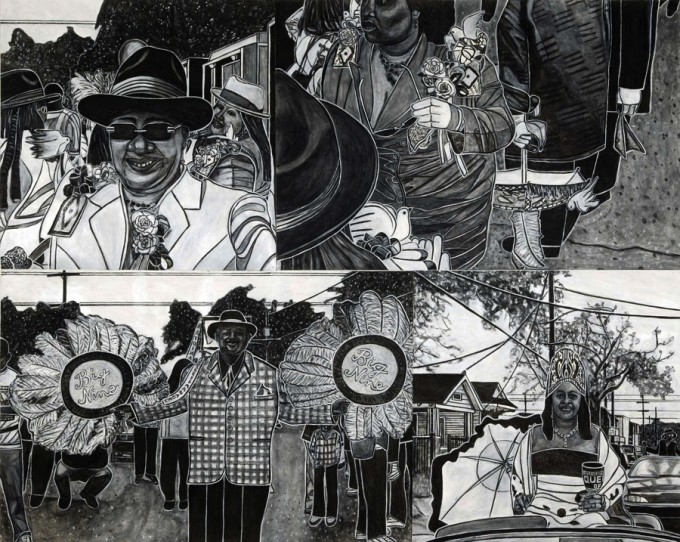
Image via Arthur Roger Gallery
“People gravitate toward truth and energy. And that’s what I’m trying to make happen, every day of my life,” Willie Birch told Satellite Magazine back in 2011 about his decision to move back to his native New Orleans in the late 1990s, after spending 20 years on the New York City art scene. “Being an artist in an African-American community is an unusual phenomenon,” he continued. “Those dudes around the corner, they’re selling drugs, but they all know me. They all respect Mr. Willie, because I don’t work for the man, I work for myself. And I can speak to them in a way that gives them dignity, so you got to respect that.” Birch doesn’t use just a single media to communicate; he’s equally adept at charcoal drawing as he is papier-mâché sculpting. While his methods may vary, his focus on creating emotionally engaging works that speak to the political, sociological, and spiritual issues of the African-American experience never wavers.

Image via Arthur Roger Gallery
Better known as just plain Ersy to her friends and vast fan base, this legendary New Orleans native proves that good things come in small packages—including great art. “I like to play with scale,” admits the artist. “I like to make the viewer confused about what space they’re in.” Still, small-scale doesn’t mean uncomplicated, and Ersy’s not afraid to present provocative ideas and imagery. Ersy’s intricate installations require a strong emotional investment on the part of the viewer; in order to fully appreciate the stories she is telling through her work, one must invest some time to look at her pieces from every angle. For example, Homage to the Society of St. Anne (above) illustrates an annual Mardi Gras morning parade, where the ashes of group members who have passed away are poured into the river.

Image via Bruce Davenport Jr.
Though he has been drawing since the age of five, it was only in the wake of Hurricane Katrina that Bruce Davenport Jr. began sharing his work with the world. The artist realized that an enormous part of the city’s musical culture was lost when the destruction of the city’s schools meant the end of school marching band culture (a key element of Mardi Gras). Davenport, who lives in the city’s Lower 9th Ward, set about reviving the tradition, at least visually. His marker reenactments of vivid marching band pageantry are done with an inimitable purity that has caught the attention of galleries and collectors near and far, including New York City’s Dieu Donné and As If Galleries. Yet Davenport has remained true to his original artistic purpose and has donated several of his pieces to local schools and libraries.
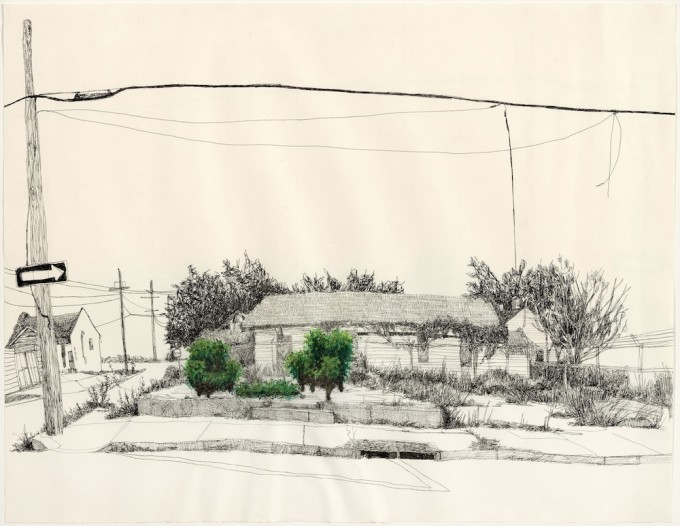
Image via Jonathan Ferrara Gallery
Though she recently relocated to Detroit to pursue an MFA in painting at the Cranbrook Academy of Art, Hannah Chalew is a NOLA artist (and native) through and through. While her work is universally relatable, it’s also very Louisiana-specific. “My work explores the continual tension between humans and nature,” states Chalew, noting that “This battle is particularly acute in post-Katrina New Orleans, where abandoned structures that have fallen into the backdrop of the city’s psyche have the full attention of Mother Nature as she slowly reclaims them. These structures become new ecosystems, post-apocalyptic spaces that are surreal—a mix of tragic and fascinating.” Inspired by her own observations in the city that surrounds her, Chalew works in both the two- and three-dimensional worlds. She divides her work into three categories—On the Wall, Off the Wall, and In Space—and regularly incorporates wood, wire, and even living plants into her creations.

Image via Josh Wingerter
Like an Andy Warhol for the digital age, Josh Wingerter’s interest is in people—both famous faces and those that are familiar to just him. Describing his work as “graffiti on canvas,” the canvases in question are any object upon which Wingerter can paint. Newspapers are a particular favorite, but they serve as more than just a vessel for absorbing the artist’s vibrant palette of paints; headlines and phrases are highlighted throughout to help tell the story of the subject in question. Charlie Chaplin (above), for example, is painted over a series of comic strips and attached to the idea of the “comic genius.”

Image via Azu Romá
Playing up the concept of reinvention, Azucena “Azu” Romá understands that art doesn’t need to be permanent in order to make an impact. Combining elements of typography, imagery, texture, and pattern, the New Orleans native is transforming the city’s landscape one ephemeral installation at a time. With sawdust and other (temporary) found materials as her preferred media, Romá deals in positivity. Whether she’s telling visitors to the Tree of Life in Audubon Park to “Live” with a 100-square-foot, hand-dyed sawdust creation or encouraging folks to “Dream” at the foot of Cabrini Bridge, she’s creating street art in its most literal sense.

Image via Hayley Gaberlavage
Hayley Gaberlavage loves a good throwback. “In my paintings I contemporize the outdated,” says the artist. “With a sentiment for bygone attitudes and appearances, my acrylic on paper, canvas and panel paintings shimmy in two directions: toward the decorative, where I explore long-time infatuation with design, and in a sociological portraiture, where innocence is equally dispersed amongst irreverent youth and the blue collar Americana of my Alabama roots.” Though her figurative works are where you’ll find the brightest pops of color—a headdress of flowers here, a unexpected pop of pink lipstick there—Gaberlavage’s leaning toward a muted palette of blues and greens is clear, particularly in her abstract and landscape pieces. Gaberlavage’s work attempts to honor the concept of memory, even with its inherent flaws. “My technique of evaporating background into swarthy brushstrokes allows time into the work, the acknowledgment of memory, which is imperfect, always unfinished, and congruous to the retro aesthetic and mood,” she says.
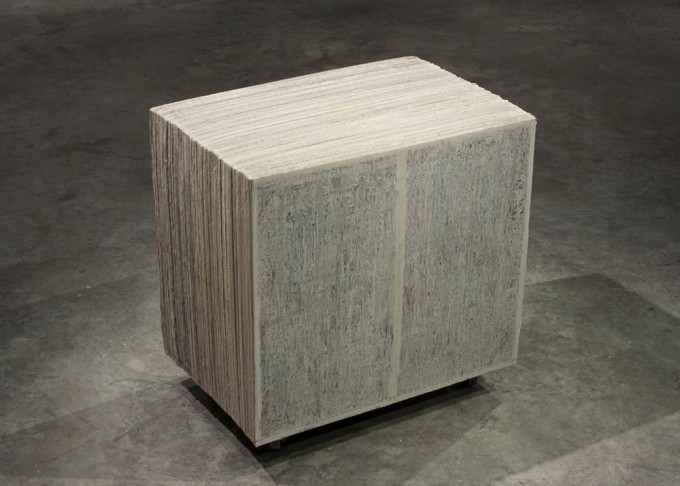
Image via Aaron McNamee
One man’s trash just may be Aaron McNamee’s next sculpture. “My interest is in the possible re-manifestations of the typically discarded object,” says the artist. “Found little bits contain a residue of existence that not only speaks specifically to issues of time, it points towards senses not easily measured.” In the case of McNamee’s ongoing laminate series, complete editions of printed media—which he entombs with glue then distresses to render them unreadable—are the material of interest. It’s more than a statement on the status of print media; for McNamee, it’s all personal. The artist chooses yearlong editions of newspapers, magazines, and comic books that have some autobiographical significance, such as the Times-Picayune (above), the local paper that ceased its daily publication in 2012.
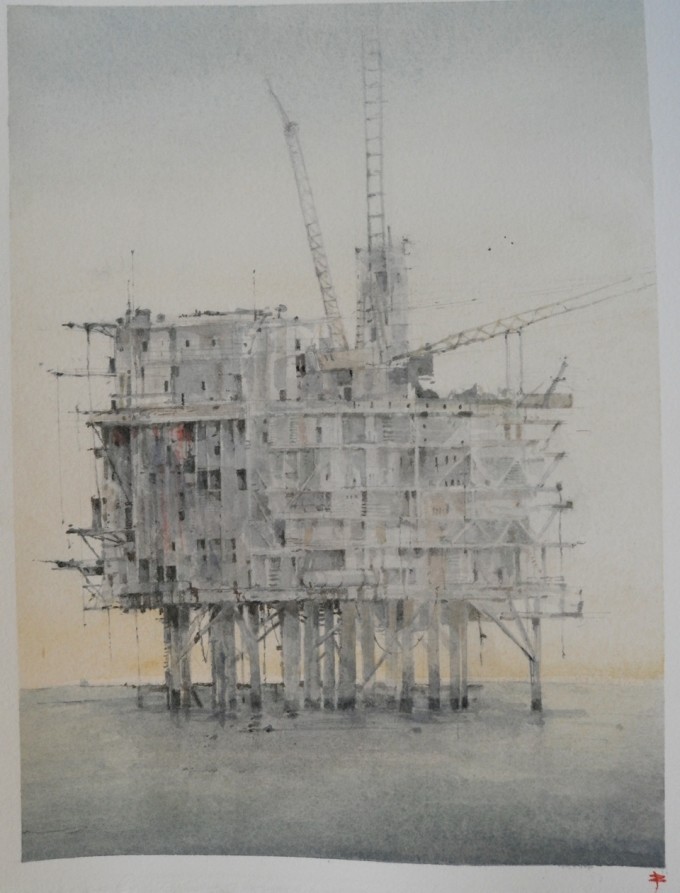
Image via Errol Barron
Errol Barron is a natural born artist. He’s the kind of person who looks at the world from a purely creative standpoint and incorporates an element of artistry into all that he does. Born in Alexandria, Louisiana, but based in New Orleans, Barron is a partner in the Errol Barron / Michael Toups Architects firm, which has been honored with more than 35 design awards around the world. He also teaches architecture and drawing at Tulane (his alma mater) and is a flautist who released a CD earlier this year. Amid all of this, Barron has also (somehow) found the time to paint, mostly in watercolor and largely in landscape. Barron’s intimate, impressionistic collection of work—which reads like a visual diary of the places he has been—has been exhibited in various group and solo shows.
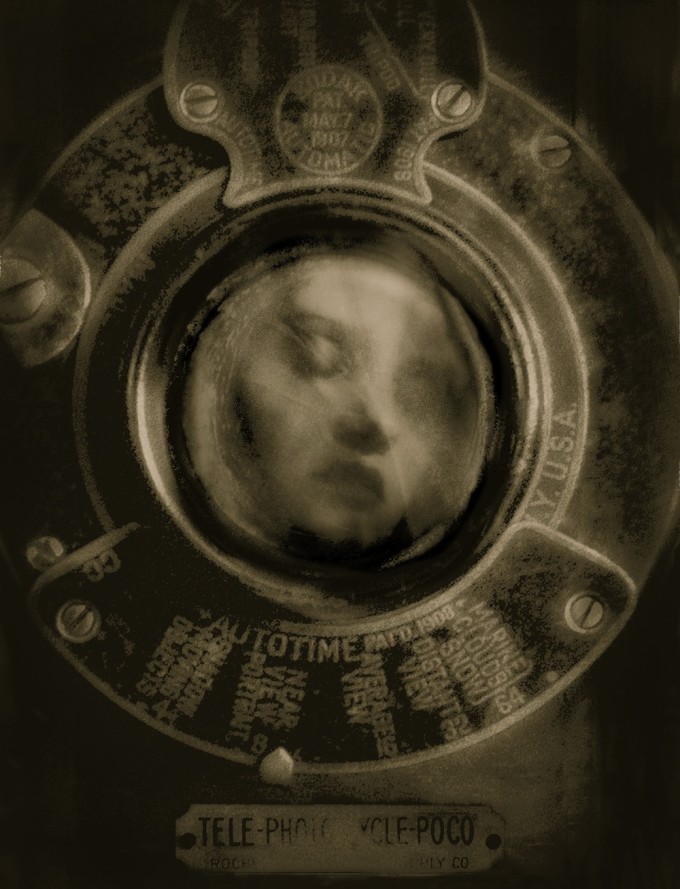
Image via Josephine Sacabo
Splitting her time between New Orleans and Mexico, Josephine Sacabo’s penchant for places that are at once both romantic and little bit surreal shines through in her work. “I believe in art as a means of transcendence and connection,” she says. “My images are simply what I’ve made from what I have been given. I hope they have done justice to their sources and that they will, for a moment, ‘stay the shadows of contentment too short lived.’” Coming from a background in photojournalism has also certainly played a part in Sacabo’s keen ability to tell an entire story with a single moment in time. Also informing her work’s dreamlike quality is the photopolymer gravure process that she employs, where she uses UV light and water to create a plate that she inks and presses the old-fashioned way. Her adoption of this process came about almost by accident—but serendipitously—as a result of photography’s transition from chemical to digital processing. “From the moment I made my first gravure, I realized I’ve been trying to do this for 30 years in the darkroom… jumping through every hoop I can think of to come up with this effect,” says Sacabo, whose one-of-a-kind works are part of the permanent collections at George Eastman House, the International Center of Photography, the Metropolitan Museum of Art, and France’s Bibliothèque Nationale. “This is what I’ve been looking for. And there’s no way they can make it obsolete.”

Image via Dawn DeDeaux
Dawn DeDeaux is an artistic force to be reckoned with. Known as a pioneering new media artist, she has been forging new creative paths for decades. Focused mainly on multimedia, digital, and conceptual art, DeDeaux’s work often utilizes a mix of immersive digital elements, two-dimensional imagery, and sculptural work to create multi-installation pieces that don’t begin and end with a simple painting. DeDeaux’s works are a multisensory experience and require more than just a split-second glance to be fully comprehended and appreciated, a fact that’s confirmed by the impressive list of institutions that have exhibited her work, including New York’s Whitney Museum and Los Angeles’ Armand Hammer Museum.
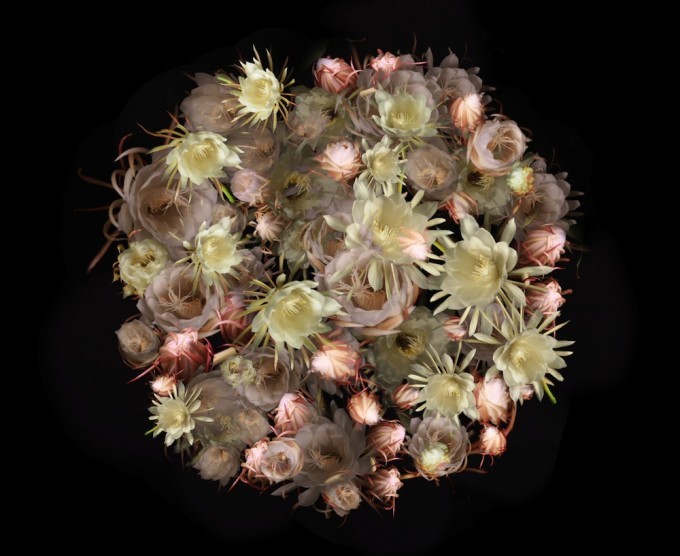
Image via Courtney Egan
The natural world meets the digital one in Courtney Egan’s projection-based sculptural installations. “I project botanical imagery onto walls, floors, and sculptural elements,” she says. “Fragments from the natural world are melded with non-natural techniques to create subtly impossible, hybrid tableaus. These electronically-forged composites place the viewer in a conversation between their memories of the natural world, and a new, mediated experience of a plant or flower.” To truly appreciate what Egan is doing, you of course have to see it in motion. While witnessing “the real world” through the lens of technology is something we all do every day, Egan’s work—which is eerily beautiful—serves as a reminder of the importance of removing the screen (be it a computer, cell phone, or television) that so often stands between us and the natural world. “The way that humans experience nature more frequently, through the mediation of the computer or television, unsettles and inspires me,” says Egan. “I am intrigued by how that experience can be enjoyable, illuminating, and disturbing simultaneously.”

Image via Jeremy Paten
When he’s not on a film set working as a set decorator or art director, Jeremy Paten is telling stories. “Stories have been shared in every culture throughout history as a means of entertainment and education, and for the transformation and passing on of traditions,” says Paten. “Storytellers are revered figures throughout history because of the magical mystique of the tale they share through their voices and minds. I too am a storyteller, although I share my tale in a different way. I use a visual narrative as an avenue to express my feelings and relate to the world around me. My hope is for the work to span cultural barriers and be accessible to any audience.” Though he studied illustration at the Memphis College of Art, Paten’s work isn’t as easy to categorize. Playing with elements of color, texture, and typography, Paten is finding new and inventive ways to tell stories with pictures.
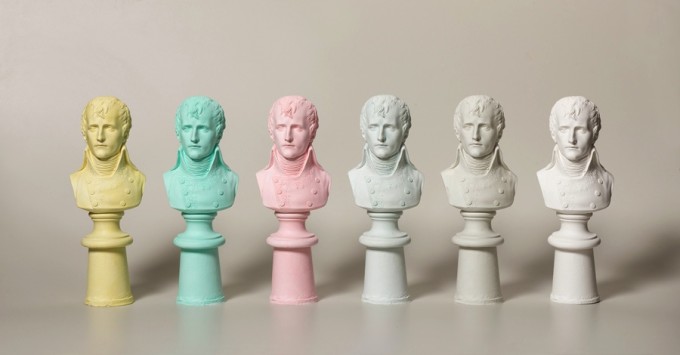
Image via Arthur Roger Gallery
As serious as the themes he plays upon may be—truth, deception, beauty, innocence, and innocence lost—there’s a sense of playfulness to the post-modernist work of Stephen Paul Day that cannot be denied. “I have always believed and dedicated my energies toward an art form that is intuitive, contextual, and entertaining,” says Day. “I have always worked on the premise that art can and does change the world. As an artist living in New Orleans, I have had the unique experience to realize authentic human significance. This position has cemented my philosophical mission as one artist among many capable of creating change.” Day, who prefers to express himself with natural materials like glass and wood, also understands that personal changes in an artist’s life will have a direct affect on his or her output. “I work as a project-based artist,” he says. “I have no real agenda. I think basically that living a significant life produces significant work.”

Image via Luis Cruz Azaceta
Don’t let the perfectly formed lines or vivid colors fool you: Luis Cruz Azaceta’s work deals in deadly serious themes. Born in Cuba, educated in New York City, and a resident of New Orleans since 1992, Azaceta’s paintings and drawings confront such challenging themes as violence, homelessness, abuse, isolation, and exile head-on. Case in point: His recent solo show at Newark’s Aljira, entitled “Dictators, Terrorism, War and Exiles.” A key figure in button-pushing art since the late 1970s, Azaceta stands in a class by himself, and his work—which is part of the permanent collections of more than 60 locations around the world, including Museum of Modern Art, The Whitney Museum of American Art, and The Metropolitan Museum of Art—is constantly evolving. “Once the work becomes mechanical, then I stop right there,” Azaceta told the Times-Picayune. “Because I like to be surprised and engaged by the process of the work.”
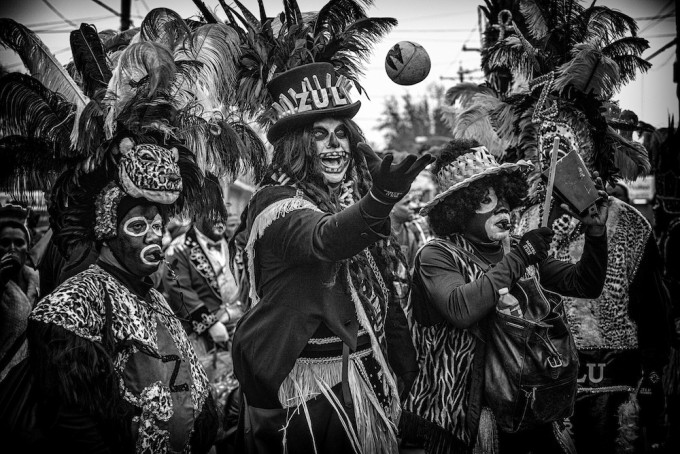
Image via Skip Bolen
Skip Bolen still vividly recalls the first photo he ever took at the age of eight with his trusty Kodak Instamatic 124 camera. It wasn’t long before his curiosity morphed into fascination and, eventually, into a fruitful career. Originally from Lafayette, Bolen moved to New Orleans shortly after earning his BFA, where he worked as a graphic designer and art director by day and spent his nights documenting the New Orleans music scene (The Ramones were one of the first bands he ever shot). He eventually landed in New York City as a junior art director at Condé Nast, where he had the opportunity to learn from some of the world’s greatest photographers. After a brief pit stop in Los Angeles, Bolen moved back to New Orleans in 2006 in order to document the rebuilding of a city—a project that continues to this day. Bolen’s deeply personal images illustrate a city in a constant state of change, with particular attention paid to its disappearing history, resulting in a body of work that is both compelling, haunting, and always original.
